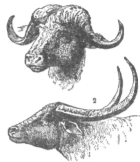BUENOS AYRES 285 BUFFALO-FISH
Description
This page of the book is from "The New Student's Reference Work: Volume 1" by Chandler B. Beach, Frank Morton McMurry and others.
BUENOS AYRES
285
BUFFALO-FISH
loss was 746 ; that of the Mexicans being 2,000.
Buenos Ayres (bo'nus â'rïz, Sp. pron. bwâ'nôs î'ras),'the federal capital of the Argentine Republic, stands on the right bank of the River Plata, 150 miles from the open sea. The river here is 36 miles across, but very shallow, a difficulty which is being remedied by a vast system of harbor works. Besides the coast and foreign trade, there is a large overland traffic to Chile. The absence of any good fuel near at hand and of stones and timber for building purposes, has been a great disadvantage to the city. It is, however, being greatly built up, in modern style, and has a number of fine buildings, among them one of the finest cathedrals in South America. The six railroads, also, which have their termini here, have many of them handsome depots. There are also a university and a military college; while its extensive mileage of street railroad lines and an extensive telephone system are among recent improvements. Europe and the United States are connected with the city by cable. Buenos Ayres was founded in 1535, but was twice destroyed by the Indians. It became independent of Spain in 1810. The commerce of the country, which passes through the ports of Buenos Ayres and Montivideo, consists chiefly of wheat and other grains, mutton, sheep-skins, wool, tallow and stéarine. Its population, including suburbs, 1,025,653; population of the province of this name, 1,392,208; area, 117,777 square miles. Buffalo. Two kinds of cattle—the Asiatic buffalo and the Cape buffalo—properly receive this name. The Asiatic form is a native of India; it has been domesticated and carried into Greece, Italy and Egypt. It is larger and more powerful than an ox. It is fond of water, and will stand for hours with only its head above the surface. The Cape buffalo is found in Central and South Africa. It grazes chiefly at night, and lies in the woods and thickets during the day. It has never been domesticated. It "is very fierce and cunning, .and often attacks without provocation, its skin is so tough that it is made into shields by the Kaffirs. The so-called American buffalo is the bison (which see).
A faithful bird-friend it has, the buffalo-bird, which closely attends it, picks parasites from its hide, and gives note of aiarm at the approach of danger. The

1. Head of Cape Buffalo
2. Head of Indian Buffalo
Indian or water - buffalo is of great service, owing to his strength and his ability- to labor in wet grounds. It is a very interesting sight to see this huge creature at work in the rice fields, his head always low down, nose thrust far in front. There are still some wild herds to be found of the Indian buffalo, the largest of all wild cattle, a very dangerous animal, able to worst a tiger in combat. The so-called American buffalo is the bison. (See Bison.)
Buffalo, a western city of New York state, at the eastern end of Lake Erie, at the head of Niagara River. It has about two and a half miles of water-front on the lake and a like amount on the Niagara River, a part of which is a bluff 60 feet high. It has one of the best harbors on the lake, formed by the Buffalo River, the entrance being protected by an immense breakwater, 4,000 feet in length. A new harbor has also been made by the building of a breakwater in the Niagara River. The city is a desirable place of residence, especially in summer, during which the lake breezes moderate the temperature. It has a beautiful series of parks connected by broad driveways. It has nearly 200 churches and many fine public and business buildings. Its railway facilities are great, while it has the advantage of the trade of the Erie Canal. Its commerce has grown wonderfully in recent years, and it is now the fourth shipping city in the New World. The first grain elevator on the lakes was built here, and it now has 41 elevators with 21,000,000 bushels' capacity. It has 1,500 manufactories, and handles great quantities of flour, lumber, coal) and mineral ores. It is supplied with natural gas, piped from Pennsylvania and from Canada, and with electric power from Niagara Falls tunnel. It has over 200 miles of street-railway and 500 miles of paved streets, including 250 miles of asphalt thoroughfares. Pure water is supplied from Lake Erie. There are a good system of public schools and several colleges and seminaries, as well as public and private libraries. The town was burned in the War of 1812 by the British and Indians. In 1901 Buffalo was the seat of the Pan-American Exposition, and the mecca for travelers and sight seers from Europe and all parts of the New World. It was here (on September 6-, 1901), that President McKinley was assassinated by an anarchist. Population, 423,715.
Buffalo = Berry, a shrub with small silvery leaves, which bears red or yellow fruit the size of a currant. It is sometimes planted as an ornamental shrub. It is a native of cold, dry regions of northwestern North America.
Buffalo Bill. See Cody, William Frederick.
Buffalo-Fish, a dark colored fish with humped back and large head, found in the


